| Listing 1 - 10 of 19 | << page >> |
Sort by
|
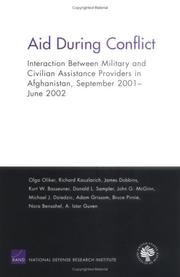
ISBN: 9786612282720 1282282727 0833040596 1598750380 0833036408 9780833040596 9780833036407 9781598750386 661228272X 9781282282728 Year: 2004 Publisher: Santa Monica, CA RAND
Abstract | Keywords | Export | Availability | Bookmark
 Loading...
Loading...Choose an application
- Reference Manager
- EndNote
- RefWorks (Direct export to RefWorks)
Assesses humanitarian-assistance efforts by and interaction between civilian and military providers in the early phases of Operation Enduring Freedom in Afghanistan; and evaluates relief, reconstruction, humanitarian, and humanitarian-type aid efforts in Afghanistan during the intense phase of military operations, from September 2001 to June 2002.
Afghan War, 2001- - Civilian relief. --- Afghan War, 2001 --- -Regions & Countries - Asia & the Middle East --- History & Archaeology --- South Asia --- Civilian relief --- -Civilian relief. --- -Operation Enduring Freedom, 2001 --- -War on Terrorism, 2001-2009 --- Civilian relief. --- -Afghan War, 2001 --- Afghan War, 2001-2021
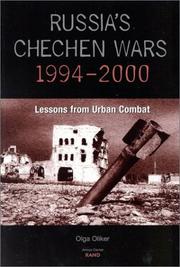
ISBN: 0833029983 9786612282621 128228262X 0833032488 9780833032485 9780833029980 9781282282629 6612282622 Year: 2001 Publisher: Santa Monica, Calif. : Rand,
Abstract | Keywords | Export | Availability | Bookmark
 Loading...
Loading...Choose an application
- Reference Manager
- EndNote
- RefWorks (Direct export to RefWorks)
Russian and rebel military forces fought to control the Chechen city of Grozny in 1994-1995 and 1999-2000, as well as clashing in smaller towns and villages. This work examines both Russian and rebel tactics and operations in those battles.
Urban warfare --- #SBIB:328H262 --- #SBIB:327.5H10 --- #SBIB:327.1H21 --- #SBIB:032.AANKOOP --- Instellingen en beleid: Rusland en het GOS --- Strategie: algemeen --- Internationale publieke opinie --- Chechn i a (Russia) - History - Civil War, 1994-. --- Urban warfare - Russia (Federation) - Chechn i a. --- City warfare --- Warfare, City --- Warfare, Urban --- Military art and science --- Chechni︠a︡ (Russia) --- History --- Chechni͡a (Russia)
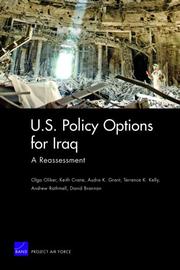
ISBN: 128118117X 9786611181178 0833042777 9780833042774 9780833041685 0833041681 9781281181176 Year: 2007 Publisher: Santa Monica, CA : Rand Corporation,
Abstract | Keywords | Export | Availability | Bookmark
 Loading...
Loading...Choose an application
- Reference Manager
- EndNote
- RefWorks (Direct export to RefWorks)
Iraq is the most pressing national security issue facing the United States today. This book evaluates the costs and benefits of five alternative strategies the United States could pursue in Iraq. The authors argue that, as long as the United States remains in Iraq, policy actions must focus on improving the security of Iraq's population by reducing violence. They offer recommendations for ways in which U.S. political, security, and economic policies in Iraq could be better geared to support this goal, though they emphasize the challenges inherent in this endeavor. Specific recommendations focu
Iraq War, 2003-2011. --- Internal security --- Anglo-American Invasion of Iraq, 2003-2011 --- Dawn, Operation New, 2010-2011 --- Gulf War II, 2003-2011 --- Iraqi Freedom, Operation, 2003-2010 --- New Dawn, Operation, 2010-2011 --- Operation Iraqi Freedom, 2003-2010 --- Operation New Dawn, 2010-2011 --- Operation Telic, 2003-2011 --- Persian Gulf War, 2003-2011 --- Telic, Operation, 2003-2011 --- War on Terrorism, 2001-2009 --- United States --- Iraq --- Irak --- Rāfidayn, Bilād --- Bilād al-Rāfidayn --- Republic of Iraq --- Jumhuriyah al Iraqiyah --- Politics and government --- Economic conditions --- Iraq War, 2003-2011 --- #SBIB:327H15 --- #SBIB:328H516 --- Buitenlandse politiek: Noord-Amerika --- Instellingen en beleid: Irak
Book
ISBN: 9780833052117 083305211X 9786613268068 0833052241 128326806X 9780833052247 9780833052223 0833052225 9781283268066 Year: 2011 Publisher: Santa Monica RAND
Abstract | Keywords | Export | Availability | Bookmark
 Loading...
Loading...Choose an application
- Reference Manager
- EndNote
- RefWorks (Direct export to RefWorks)
Security force assistance (SFA) is a central pillar of the counterinsurgency campaign being waged by U.S. and coalition forces in Afghanistan. The outcome of the campaign hinges, in large measure, on the effectiveness of the assistance given to the Afghan National Army, Afghan National Police, and other security forces, assistance that the International Security Force must provide while fighting the insurgents. Yet senior U.S. military and civilian officials have posed many questions about the effectiveness of SFA in Afghanistan, and no empirically rigorous assessments exist to help answer these questions. This monograph analyzes SFA efforts in Afghanistan over time and documents U.S. and international approaches to building the Afghan National Security Forces from 2001 to 2009. Finally, it provides observations and recommendations that emerged from extensive fieldwork in Afghanistan in 2009 and their implications for the U.S Army.
Military assistance, American --- National security --- Internal security --- #SBIB:327.5H30 --- Security, Internal --- Insurgency --- Subversive activities --- Militaire organisaties – leger- stijdkracht --- Afghanistan. --- Afghan National Army --- ANA (Afghan National Army) --- Afghanistan National Security Forces. --- Subversive activitiesMilitaire organisaties – leger- stijdkrachtAfghanistan. --- افغانستان. --- Afghanistan. Afghan National Army. --- Internal security -- Afghanistan. --- Military assistance, American -- Afghanistan. --- National security -- Afghanistan. --- Combined operations (Military science) --- Stability operations --- Armed Forces --- Counterinsurgency --- Counterguerrilla warfare --- Guerrilla warfare --- Allied operations (Military science) --- Military art and science --- Strategy --- Tactics --- Armed Services --- Military, The --- Disarmament --- International Security Assistance Force (Afghanistan) --- North Atlantic Treaty Organization --- North Atlantic treaty organisation --- NAVO --- OTAN --- ISAF --- North Atlantic Treaty Organization. --- Kumak aw Hamkārī (Afghanistan) --- United States --- Stability operations. --- Stabilization operations --- NATO --- Afghanistan National Army
Book
ISBN: 0833052144 9786613268075 0833052446 1283268078 9780833052445 9781283268073 9780833052148 9780833052148 6613268070 Year: 2011 Publisher: Santa Monica, Calif. RAND Corp.
Abstract | Keywords | Export | Availability | Bookmark
 Loading...
Loading...Choose an application
- Reference Manager
- EndNote
- RefWorks (Direct export to RefWorks)
Through a variety of policies and actions--and most recently in a new military doctrine adopted in February 2010--Russia has indicated the types of situations and threats that might cause it to resort to using nuclear weapons. This volume examines Russia's evolving framework for nuclear deterrence and its implications for U.S. military operations in Europe.
Deterrence (Strategy). --- Nuclear weapons -- Russia (Federation). --- Russia (Federation) -- Military policy -- 21st century. --- Deterrence (Strategy) --- Military & Naval Science --- Law, Politics & Government --- Armies --- Nuclear weapons --- #SBIB:328H262Collectieve veiligheid --- Instellingen en beleid: Rusland en het GOSE-books --- #SBIB:327.5H11 --- #SBIB:327.5H22 --- #SBIB:328H262 --- Military policy --- Psychology, Military --- Strategy --- First strike (Nuclear strategy) --- Nuclear crisis stability --- Collectieve veiligheid --- Ontwapeningsproblemen - bewapening --- Instellingen en beleid: Rusland en het GOS --- Europe --- Russia (Federation) --- Russian Federation --- Rossiyskaya Federatsiya --- Rossiya (Federation) --- Rossii︠a︡ (Federation) --- Российская Федерация --- Rossiĭskai︠a︡ Federat︠s︡ii︠a︡ --- Російська Федерація --- Rosiĭsʹka Federat︠s︡ii︠a︡ --- Federazione della Russia --- Russische Föderation --- RF --- Federation of Russia --- Urysye Federat︠s︡ie --- Правительство России --- Pravitelʹstvo Rossii --- Правительство Российской Федерации --- Pravitelʹstvo Rossiĭskoĭ Federat︠s︡ii --- Правительство РФ --- Pravitelʹstvo RF --- Rosja (Federation) --- O-lo-ssu (Federation) --- Roshia Renpō --- Federazione russa --- OKhU --- Orosyn Kholboony Uls --- Russian S.F.S.R. --- Council of Europe countries --- Eastern Hemisphere --- Eurasia --- Military relations --- E-books --- Eluosi (Federation) --- 俄罗斯 (Federation) --- Military policy. --- RF (Russian Federation) --- Россия (Federation)
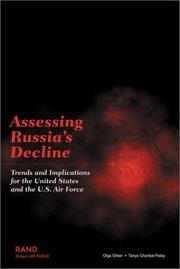
ISBN: 0833033840 0833030957 9780833033840 9780833030955 Year: 2002 Publisher: Santa Monica, CA Rand
Abstract | Keywords | Export | Availability | Bookmark
 Loading...
Loading...Choose an application
- Reference Manager
- EndNote
- RefWorks (Direct export to RefWorks)
Continuing trends toward military, political, economic, and social decline in Russia threaten the interests of the United States and its allies. Moscow?s capacity to govern is called into question by increasing crime and corruption (and by political and economic regionalization). Both the military nuclear arsenal and the civilian nuclear power sector present risks of materials theft or diversion, as well as of tragic accident. An increasingly aging and ailing population bodes ill for Russia?s future. Reversing the country?s economic decline and rebuilding an effective military have proven
Armies. --- Russia (Federation)--Strategic aspects. --- United States. Air Force. --- Military & Naval Science --- Law, Politics & Government --- Armies --- United States. --- Russia (Federation) --- Strategic aspects. --- Army --- Military power --- AF --- Air Force (U.S.) --- U.S.A.F. --- United States Air Force --- US Air Force --- USAF --- Russian Federation --- Rossiyskaya Federatsiya --- Rossiya (Federation) --- Rossii︠a︡ (Federation) --- Российская Федерация --- Rossiĭskai︠a︡ Federat︠s︡ii︠a︡ --- Російська Федерація --- Rosiĭsʹka Federat︠s︡ii︠a︡ --- Federazione della Russia --- Russische Föderation --- RF --- Federation of Russia --- Urysye Federat︠s︡ie --- Правительство России --- Pravitelʹstvo Rossii --- Правительство Российской Федерации --- Pravitelʹstvo Rossiĭskoĭ Federat︠s︡ii --- Правительство РФ --- Pravitelʹstvo RF --- Rosja (Federation) --- O-lo-ssu (Federation) --- Roshia Renpō --- Federazione russa --- OKhU --- Orosyn Kholboony Uls --- Armed Forces --- Russian S.F.S.R. --- AF (Air force) --- U.S.A.F. (Air force) --- USAF (Air force) --- Eluosi (Federation) --- 俄罗斯 (Federation) --- RF (Russian Federation) --- Россия (Federation)
Book
ISBN: 1283597365 9786613909817 0833051717 0833051687 9780833051714 9780833051691 0833051695 9780833051684 Year: 2011 Publisher: Santa Monica, CA RAND
Abstract | Keywords | Export | Availability | Bookmark
 Loading...
Loading...Choose an application
- Reference Manager
- EndNote
- RefWorks (Direct export to RefWorks)
Security force assistance is central to the counterinsurgency campaign of U.S. and coalition forces in Afghanistan. The outcome will hinge on the effectiveness of the assistance provided to the Afghan National Army, Afghan National Police, and other security forces. This report provides an overview of Soviet efforts to improve and facilitate the training and development of Afghan security forces.
Afghanistan -- History -- Soviet occupation, 1979-1989. --- Afghanistan -- History, Military -- 20th century. --- Internal security -- Afghanistan. --- Military assistance, Soviet -- Afghanistan. --- Soviet Union -- History, Military. --- Military assistance, Soviet --- Internal security --- Soviet Union --- Regions & Countries - Asia & the Middle East --- History & Archaeology --- South Asia --- History, Military --- Afghanistan --- History, Military. --- History --- Security, Internal --- Soviet military assistance --- Afganistan --- A-fu-han --- República Democrática de Afganistán --- DRA --- Republic of Afghanistan --- Democratic Republic of Afghanistan --- Aphganistan --- Afeganistão --- Islamic State of Afghanistan --- Islamic Emirate of Afghanistan --- Islamic Republic of Afghanistan --- Affghanistan --- Efẍanistan --- Jumhūrī-i Islāmī-i Afghānistān --- جمهورى اسلامى افغانستان --- Afghānistān Islāmī Imārat --- افغانستان --- Jomhūrī-ye Eslāmī-ye Afġānestān --- Da Afġānistān Islāmī Jumhoryat --- Afġānistān Islāmī Jumhoryat --- Афганистэн --- Afganistėn --- Афганистэн Мыслимэн Республикэ --- Afganistėn Myslimėn Respublikė --- Islamitiese Republiek van Afghanistan --- Ahyganitã --- Tetã Islãrehegua Ahyganitã --- Ăfqanıstan --- Ăfqanıstan İslam Respublikası --- Afghanstan --- Afghanstan Islam Respublikaḣy --- Афганістан --- Afhanistan --- Ісламская Рэспубліка Афганістан --- Islamskai︠a︡ Rėspublika Afhanistan --- Apganistan --- Islamikong Republika kan Apganistan --- Афганистан --- Ислямска република Афганистан --- Isli︠a︡mska republika Afganistan --- Islamska republika Afganistan --- Republik Islamek Afghanistan --- Afghánská islámská republika --- Affganistan --- Gweriniaeth Islamaidd Affganistan --- Insurgency --- Subversive activities --- Jamhuri-ye Islami-ye Afghanistan --- アフガニスタン --- Afuganisutan
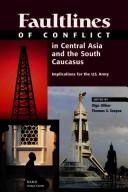
ISBN: 0833032607 9786612451201 0833048341 1282451200 1598751190 9780833048349 9781282451209 9781598751192 9780833032607 Year: 2003 Publisher: Santa Monica, CA RAND
Abstract | Keywords | Export | Availability | Bookmark
 Loading...
Loading...Choose an application
- Reference Manager
- EndNote
- RefWorks (Direct export to RefWorks)
In this volume, the authors identify and evaluate key faultlines in Central Asia and the South Caucasus and how they affect the likelihood and possible evolution of armed conflict in these regions. The analysis examines the ways in which the emergence of conflict could draw the US into the strife.
United States. --- Foreign service --- Asia, Central --- Caucasus --- United States --- Asie centrale --- Caucase --- Etats-Unis --- Strategic aspects --- Military policy --- Aspect stratégique --- Politique militaire --- Caucasia --- Caucasus Mountains --- Caucasus Region --- Kavkaz --- Soviet Central Asia --- Tūrān --- Turkestan --- West Turkestan --- National security --- U.S. Army --- US Army --- Central Asia --- Asia --- Strategic aspects. --- Military policy.
Book
ISBN: 0833096001 9780833096005 9780833095978 0833095978 Year: 2016 Publisher: Santa Monica, Calif.
Abstract | Keywords | Export | Availability | Bookmark
 Loading...
Loading...Choose an application
- Reference Manager
- EndNote
- RefWorks (Direct export to RefWorks)
"The Maidan Revolution in Ukraine created an opportunity for change and reforms in a system that had resisted them for 25 years. This report examines Ukraine's security sector--assessing what different institutions need to do and where gaps exist--and offers recommendations for the reform of Ukraine's security and defense institutions that meet Ukraine's security needs and align with Euro-Atlantic standards and approaches."--Provided by publisher.
Security sector --- National security --- Internal security --- Security, Internal --- Insurgency --- Subversive activities --- Homeland security sector --- Internal security sector --- National security sector --- Public administration --- Ukraine --- An Úcráin --- I-Yukreyini --- IYukreyini --- Malorosii︠a︡ --- Małorosja --- Oekraïne --- Ookraan --- Oukraïne --- Oykrania --- Petite-Russie --- U.S.R.R. --- Ucrægna --- Úcráin --- Ucraina --- Ucrania --- Ucrayena --- ʻUkelena --- Ukraïna --- Ukrainæ --- Uḳraʼinah --- Ukrainian Council Socialist Republic --- Ukrainian S.S.R. --- Ukrainian Socialist Soviet Republic --- Ukrainian Soviet Socialist Republic --- Ukrainio --- Ukrainmudin Orn --- Ukraïnsʹka Radi︠a︡nsʹka Sot︠s︡ialistychna Respublika --- Ukrainska Radyanska Sotsialistychna Respublika --- Ukrainska Sotsialistychna Radianska Respublika --- Ukraïnsʹka Sot︠s︡ii︠a︡listychna Radi︠a︡nsʹka Respublika --- Ukrainskai︠a︡ Sovetskai︠a︡ Sot︠s︡ialisticheskai︠a︡ Respublika --- Ukrainskaya Sovetskaya Sotsialisticheskaya Respublika --- Ukrainujo --- Ukrajina --- Ūkrāniyā --- Ukranya --- Ukrayiina --- Ukrayina --- Ukrayna --- Ukuraina --- Ukyáña --- Wcráin --- Yn Ookraan --- Yr Wcráin --- Yukrain --- Ουκρανία --- Украинæ --- Украина --- Украинэ --- Украинмудин Орн --- Україна --- אוקראינע --- אוקראינה --- أوكرانيا --- ウクライナ --- 우크라이나 --- Ukraine (Hetmanate : 1648-1782) --- Armed Forces --- Reorganization.
Book
ISBN: 1977405053 9781977401953 1977401953 9781977405050 Year: 2019 Publisher: Sant Monica, Calif.
Abstract | Keywords | Export | Availability | Bookmark
 Loading...
Loading...Choose an application
- Reference Manager
- EndNote
- RefWorks (Direct export to RefWorks)
The authors provide an overview of the current state of the Russian military in terms of funding and capabilities across the bulk of its forces. They describe how Russian defense budgets have increased over the course of the past 15 years, even as Russian defense spending has now entered a period of decline. They also portray a Russian military in transition, on a path to adapt its general-purpose forces to provide options more suitable to Russia's needs and intentions. They conclude that, based on the location of Russian forces and the systems that the Russian government and military have emphasized for modernization, the Russian government and military have successfully strengthened Russia's military capabilities for a distinct set of future conflict scenarios. It is important to pay close attention to Russia's modernization of its advanced air defenses and ground forces, especially its long-range fires systems — a process that has improved both its offensive and defensive capabilities. The Russian military has also improved its overall readiness level, which has resulted in an ability to quickly generate significant ground forces and to rapidly project antiair and antisea capabilities around its borders. This gives the country substantial offensive potential against bordering states, especially other former Soviet republics.
Armed Forces --- Military planning --- Military policy. --- Defense budgets --- Military budgets --- Armed Services --- Military, The --- Military art and science --- Disarmament --- Defense policy --- Military readiness --- Military history --- Sociology, Military --- War --- National security --- War planning --- Military administration --- Military policy --- Planning --- Reorganization. --- Appropriations and expenditures. --- Political aspects --- Russia (Federation) --- Russian Federation --- Rossiyskaya Federatsiya --- Rossiya (Federation) --- Rossii︠a︡ (Federation) --- Российская Федерация --- Rossiĭskai︠a︡ Federat︠s︡ii︠a︡ --- Російська Федерація --- Rosiĭsʹka Federat︠s︡ii︠a︡ --- Federazione della Russia --- Russische Föderation --- RF --- Federation of Russia --- Urysye Federat︠s︡ie --- Правительство России --- Pravitelʹstvo Rossii --- Правительство Российской Федерации --- Pravitelʹstvo Rossiĭskoĭ Federat︠s︡ii --- Правительство РФ --- Pravitelʹstvo RF --- Rosja (Federation) --- O-lo-ssu (Federation) --- Roshia Renpō --- Federazione russa --- OKhU --- Orosyn Kholboony Uls --- Russian S.F.S.R. --- Operational readiness --- Evaluation. --- Appropriations and expenditures --- Eluosi (Federation) --- 俄罗斯 (Federation) --- RF (Russian Federation) --- Россия (Federation)
| Listing 1 - 10 of 19 | << page >> |
Sort by
|

 Search
Search Feedback
Feedback About UniCat
About UniCat  Help
Help News
News